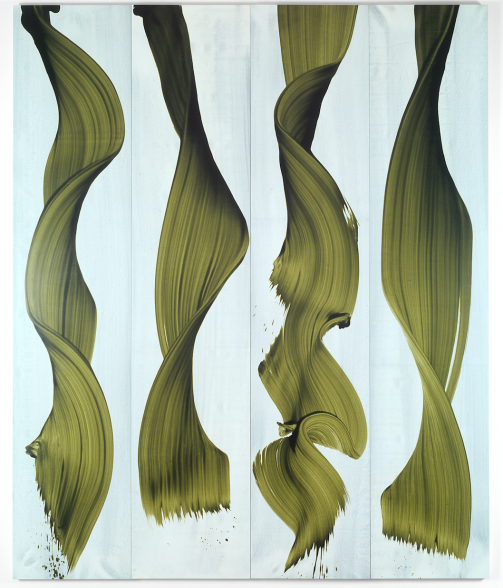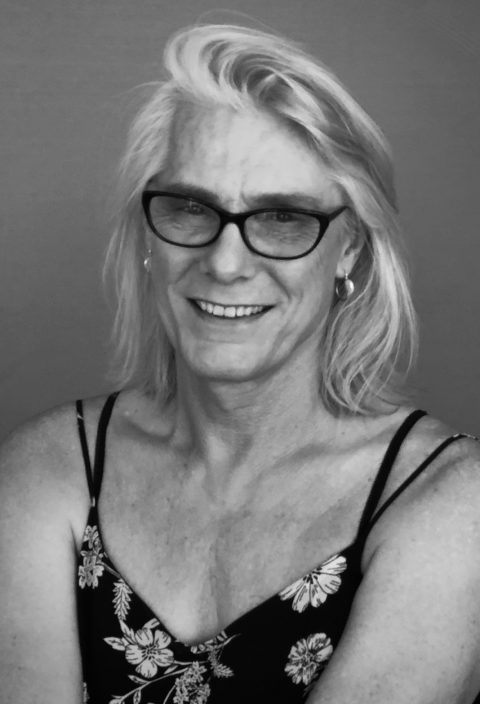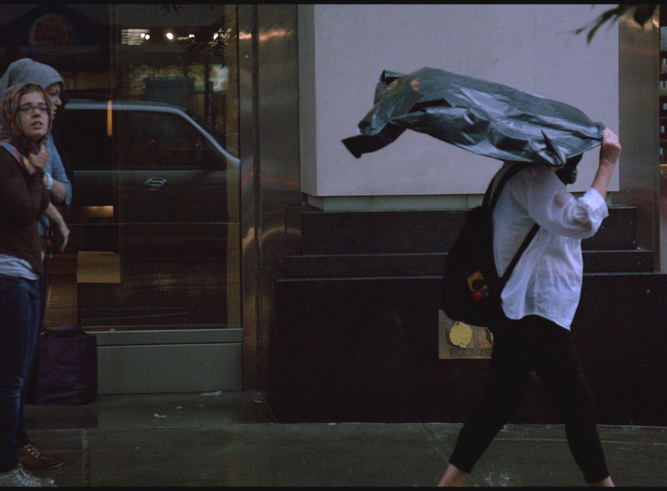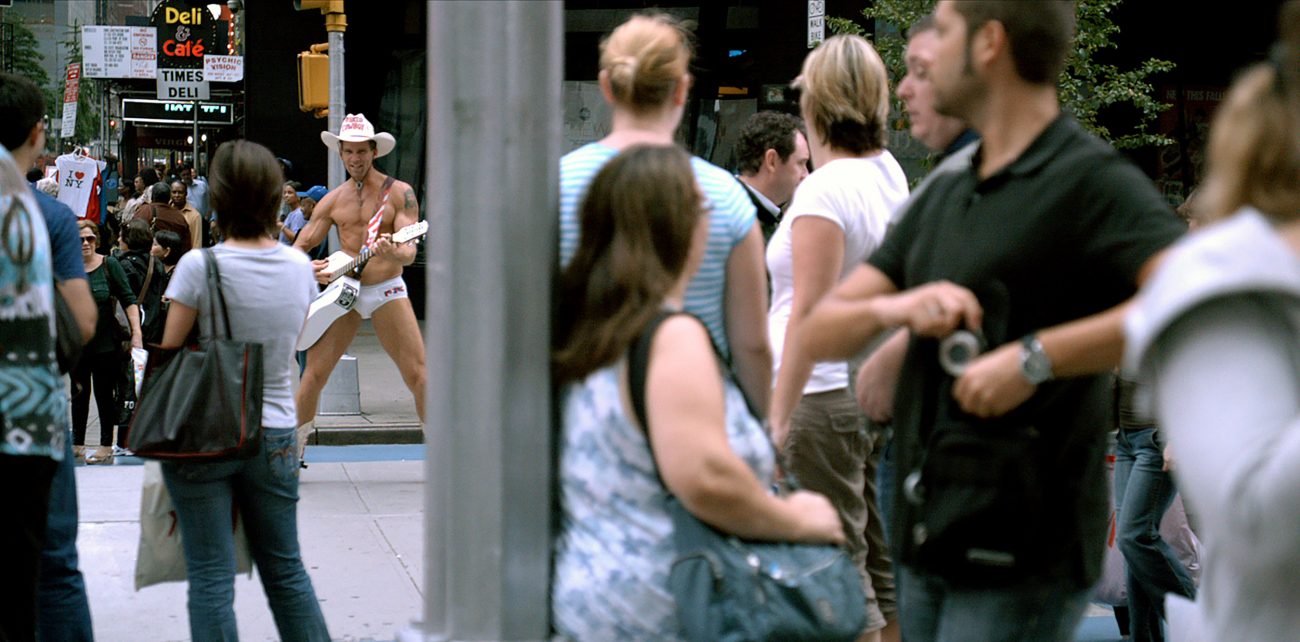STREETS, 2011, HD video, 61 mins
Working at the edge of painting, photography, music and film over the course of five decades, Jamie Nares has profoundly explored the relationships between memory, time, movement and thought. I spoke with Jamie about her childhood, her move to New York City in the 1970s, her multidisciplinary practice, and her generous vision of art and life.
COM: We were just talking about London, and you were born in London. What drew you to New York City and when did you settle in New York?
JN: Well, I was born in London, but I grew up in the country from the age of three onwards. My father had died when I was three and just before that he built us this house in the country. So that's where I grew up. And then I was sent off to boarding schools when I was seven. Horrible boarding schools. So, I never really lived at home. And I think that it made it easy for me when I landed in New York and realized that it felt like I was home for the first time in my life. It was easy for me to stay because I had been leaving home all my life. But I came in 1974. I came because I was interested in all the American artists. They were the ones that interested me most, and I wanted to be around it. And I lucked out because a friend of mine had just rented a big loft in in Tribeca, which was... the kind of ground zero was the art community at that point. It shifted from Soho down to Tribeca and there were so many artists who I admired, and I'd read about so much living there and I just jumped right into the middle of it. It was a stroke of immensely good fortune.
COM: That's fantastic. What are some of the names of artists that you were thinking about or looking at that drew you to the city?
JN: Richard Serra, Mel Bochner, Vito Acconci, Bruce Nauman, although he just moved to California at that time... Oh, my mind's gone blank but it seemed like everyone was there, from Claes Oldenburg to my small circle of contemporaries who were all interested in the same things.
COM: It must have been a really different New York than it is now...
JN: Keith Sonnier. Sorry, I'm thinking of names that are beginning to pile into my brain. I was thinking Keith Sonnier who was wonderful. And then Willoughby Sharp and Lisa Béar who did Avalanche magazine, which was my favorite magazine. And the list goes on.
COM: What a what a great moment. How did the 1970s downtown Manhattan art scene shape you? I bet in many different ways.

Tetragram, 1999, oil on linen 108 x 92 in.
JN: Many different ways. I kind of came of age there, the way I see it. I had I been the art school in London for not even a year, just two semesters when my friend suggested that I come over and I just came straight over... New York in the seventies, especially down there, was a ghost town. It was great. It seemed like the whole city below 14th Street was very, very depopulated, and we never went above 23rd Street. 23rd Street was way uptown. Although that's not strictly true, because we were also great adventurers. We'd go up to Harlem to drink in little bars. But we were so welcomed, they loved seeing those little fresh, young, white faces. It was a great time. It seemed like you could do anything and get away with it, or not. I got arrested a couple of times, but stupid things.
COM: It sounds like a moment full of possibilities.
JN: It was. The world seemed wide open. And it was just perfect for me because, you know, when I arrived and I looked around, I understood painters like Robert Rauschenberg. Because on every street corner, there was something that looked like a painting by him. You know, some pipes sticking out of a wall painted with a bright red enamel or something. There were little details of the city that just, I understood where all the art that I had loved came from. And I just fell into it.
COM: You also played the guitar in various groups.
JN: I was in various bands, in two bands.
COM: How did musicality influence you at that time that you were beginning to develop your practice in the visual arts?
JN: Well, there was always a musical element in what I did. Sometimes directly, like I did a performance where I went up to Central Park, sat on a bench with a guitar which I completely detuned, and strummed away for an afternoon. Much to the surprise of people sitting on those park benches. But music was always a big part of my life. I grew up in a very musical household. Rhythm has always been a very important element in my work. And we used to fuck around with guitars and tape recorders. We had instruments. We were playing very, very sort of wild experimental stuff. And it seemed like everybody was. It was just a time of incredible creativity. When 1976 happened. Oh, I like that "when 1976 happened..." [Laughs]. When it rolled on by, things changed or began to change. But by 1977, there was a kind of malaise in the art world and a kind of frustration on the part of younger artists that they weren't being seen or heard. And we became more vocal and visible doing things. There was Colab, this group of artists that did a lot of stuff. There was The Times Square Show, the Doctors & Dentists show, and all these shows that we put together as groups. But then, as happens with groups so often, it began to splinter up into factions and individuals and I was one of the first to break off from that life. I couldn't stand the kind of bureaucratic, starting of a business.

Portrait of Jamie Nares, 2021, Katherine Stewart.
COM: So, there was a period in those early years where you were more involved with creating your own spaces to show your work in and to be a platform for other artists, right?
JN: Yeah, we had a space in the garage that was underneath where I lived and where landlords kept their enormous Lincoln town cars and things during the daytime. But in the evenings, it was just an empty garage, and we would go in there with a movie screen that we built, a collapsible movie screen, and put it up and show films and do performances and have music played. That was the first place I saw James Chance, who led The Contortions a year or so later. He was playing a duo, him and this drummer. So, we did. We invaded spaces, we used them as movie backdrops. We used them as very alternative exhibition places. We were in and out of a lot of buildings, but there was a lot of empty buildings, you know? It was crazy.
COM: Right, not like it is today.
JN: Not like it is today, it's true. The only empty buildings now are the ones in Hudson Yards and places like that where they've built all these high rises that nobody lives.
COM: Yeah. It must be kind of wild to think back on all of the different New York cities that you have experienced over the past 50 years.
JN: That's true. The Giuliani years, which was pretty awful. The AIDS epidemic. All these things shaped who I am and my practice.
COM: I imagine. What were some of the early works that you started developing? Were you focusing on a particular medium or were you working across various?
JN: I was working across various mediums. I did a lot of video and film. I wasn't really painting, but I did a lot of drawings. I was always drawing and making sketches for, you know, ideas for events. But the most formed artwork that came out of that of mine was in my movie “Pendulum” which has been getting a lot of play lately. I thought I lost it, but I found it in deep storage a few years ago and people really like that one. But I was making sure a lot of short movies, too, like three-minute movies or ten-minute movies. And making objects and all kinds of stuff, doing performances. You know, I painted when I was a youngster and I didn't really paint at school either. I did other things always. Photo pieces. My work was more conceptual. When I was a student, I remember I would do things like, I'd go into the common room in the middle of the night and moved everything, every object, one inch to the north or something. And then I would put up a sign on the door saying, "every object in this room was moved one inch to the North last night." And just leave it for people to kind of go "Ah!" There was a lot of humor in my work and wordplay and stuff.

STREET, 2011, HD video, 61 mins.
COM: You were at the School of Visual Arts, correct?
JN: Yes. Again, I stayed there two semesters. Seems to be a pattern of mine. But I always knew what I wanted to do. And I just did it. I didn't really take advantage of the teachers that were there in both art schools. But, you know, it was okay in the end because I just did what I was doing. It was discovering a lot about, you know, like how the education system worked. Like I showed up at the first day school and was expecting to be told where to go and what to do. I didn't realize you had to sign up for classes. So, all the teachers that I had seen listed on the School of Visual Art's official advertising bill, their advertising was very good, all those teachers' classes were full. And I had slim pickings, although I ended up with some good teachers. Hannah Wilkie who died sadly. It was a good way to get acquainted with New York, and America and meet other people.
Working at the edge of painting, photography, music and film over the course of five decades, Jamie Nares has profoundly explored the relationships between memory, time, movement and thought. I spoke with Jamie about her childhood, her move to New York City in the 1970s, her multidisciplinary practice, and her generous vision of art and life.
Continued in Part 2


